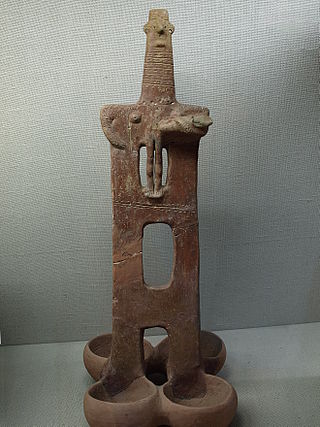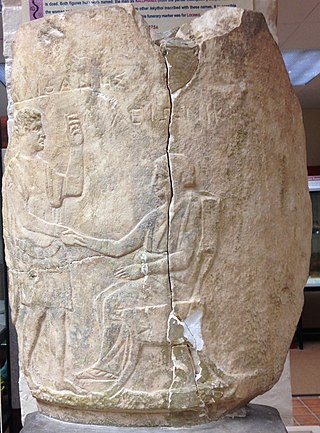
Dame Kathleen Mary Kenyon, was a British archaeologist of Neolithic culture in the Fertile Crescent. She led excavations of Tell es-Sultan, the site of ancient Jericho, from 1952 to 1958, and has been called one of the most influential archaeologists of the 20th century. She was Principal of St Hugh's College, Oxford, from 1962 to 1973, having undertaken her own studies at Somerville College, Oxford.

The Prehistoric Period is the oldest part of Cypriot history. This article covers the period 11,000 to 800 BC and ends immediately before the documented history of Cyprus begins.
This is a timeline of Cypriot history, comprising important legal and territorial changes and political events in Cyprus. To read about the background to these events, see History of Cyprus. See also the list of presidents of Cyprus.

Tall al-Ajjul or Tell el-'Ajul is an archaeological mound or tell in the Gaza Strip. The fortified city excavated at the site dates as far back as ca. 2000-1800 BCE and was inhabited during the Bronze Age. It is located at the mouth of Wadi Ghazzah just south of the town of Gaza.
Marki Alonia is a prehistoric settlement in central Cyprus. Excavations were carried out at the site between 1990 and 2000 by David Frankel and Jennifer Webb of La Trobe University. These showed that it was occupied from the earliest phase of the Early Bronze Age until well into the Middle Bronze Age. It is the most extensively excavated site of the period, and the only one with a long sequence of occupation, which provides evidence for the development of Philia culture.
Peter M. Fischer is an Austrian-Swedish archaeologist. He is a specialist on Eastern Mediterranean and Near Eastern archaeology, and archaeometry. He belongs to the University of Gothenburg and is associated with the Austrian Academy of Sciences, Sweden. He is the founder and director of the Swedish Jordan Expedition, the Palestinian-Swedish Expedition at Tall al-Ajjul, Gaza. He became the director of the Swedish Cyprus Expedition in 2009 and carried out excavations at Hala Sultan Tekke since 2010. He is member/corresponding member of The Royal Society of Arts and Sciences in Gothenburg, Royal Swedish Academy of Letters, History and Antiquities. and The Austrian Academy of Sciences.

The Philia culture existed on the island of Cyprus at the start of the Early Bronze Age between 2450 and 2200 BC. It derives its name from a location in Morphou, Cyprus.

Honor Frost was a pioneer in the field of underwater archaeology, who led many Mediterranean archaeological investigations, especially in Lebanon, and was noted for her typology of stone anchors and skills in archaeological illustration.

The Museum of Classical Archaeology is the teaching collection of the Department of Classics, Archaeology and Ancient History at the University of Adelaide in South Australia.

The Archaeology Museum of the American University of Beirut in Beirut, Lebanon is the third oldest museum in the Near East after Cairo and Constantinople.
David Frankel is Emeritus Professor in Archaeology, Faculty of Humanities and Social Sciences, Department of Archaeology and History at La Trobe University.
Hector William Catling, CBE, FSA was a British archaeologist who served as director of the British School at Athens between 1971 and 1989.

Cypriot Bichrome ware is a type of Late Bronze Age, and Iron Age, pottery that is found widely on Cyprus and in the Eastern Mediterranean. This type of pottery is found in many sites on Cyprus, in the Levant, and also in Egypt. It was typically produced on a pottery wheel. A large variety of decorations and motifs are attested. This pottery is very similar to certain types of the Mycenaean pottery from various locations.
Marie Louise Stig Sørensen is a Danish archaeologist and academic. She is Professor of European Prehistory and Heritage Studies at the University of Cambridge and Professor of Bronze Age Archaeology at the University of Leiden. Her research focuses on Bronze Age Europe, heritage, and archaeological theory.
Susan Sherratt is Reader in Mediterranean Archaeology at the University of Sheffield. Her research focuses on the archaeology of the Bronze and Early Iron Ages of the Aegean, Cyprus and the eastern Mediterranean, especially trade and interaction within and beyond these regions.
The archaeology of Cyprus involves the analysis of human activity derived from Cypriot artefacts and architecture from the Neolithic through to the British period. The earliest archaeological discoveries in Cyprus are attributed to European amateur collectors or “treasure hunters” during the early 19th century. By the mid 19th century, systematic fieldwork and excavations were conducted on various sites involving studying the remains of Cypriot cemeteries and tombs, maritime artefacts, architecture, pottery as well as a range of other individual artefacts. Subsequent findings and analysis detail the social and physical landscapes of ancient Cyprus as well as their evolving culture, religious beliefs and technology throughout antiquity.
John Franklin Daniel III was an American archaeologist, known for his work on deciphering the Cypro-Minoan script.
Menelaos Markides was a Cypriot archaeologist and the first curator of the Cyprus Museum (1912-1931).
Carole McCartney was a Pittsburgh-born Cypriot archeologist. She studied archaeology at the University of Edinburgh, finishing her masters (1989) and her PhD (1996) with her doctoral thesis titled, The Analysis of Variability in Simple Core Technologies: Case Studies of Chipped Stone Technology in Post-PPN Assemblages from the Levant.
Louise Steel is Professor of Near Eastern Archaeology at the University of Wales Trinity St David. Her research focuses on the prehistoric Mediterranean world, in particular Cyprus and the Eastern Mediterranean, as well as on themes of materiality and the human body. She conducts fieldwork in Cyprus at the Late Bronze Age site of Arediou Vouppes.







